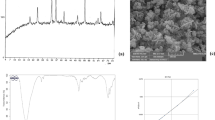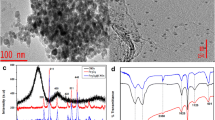Abstract
Purpose
A new microextraction technique termed COU-2 dispersive micro-solid phase extraction (COU-2-D-μ-SPE) has been developed. The proposed method utilized synthesized mesoporous carbons, COU-2, as sorbent for sample pretreatment in the determination of cloxacillin (CLOX) in water.
Methods
The optimized conditions involved the use of 100 mg of COU-2 as adsorbent, 50 mL of water sample at pH 2 containing 10 % (w/v) sodium chloride in a sample tube, 1 min of extraction time, methanol as desorption solvent, and 5 min of desorption time. After extraction, COU-2 was collected on a filter and CLOX was desorbed with 300 µL of methanol and dried under a gentle stream of nitrogen. The extract was then reconstituted to 60 µL with distilled water.
Results
Under the optimized conditions, the method showed excellent detection and quantification limits for CLOX (0.06 and 0.17 µg L−1, respectively) with good reproducibility (relative standard deviation <8 %) for both intra- and inter-day analyses. The method provided acceptable extraction recoveries for drinking water samples in the range of 89.7–113.6 %. The extraction of blank samples indicated that both samples were free from CLOX contamination. The high recoveries and good precision for CLOX suggest that the COU-2-D-μ-SPE is potentially a good alternative microextraction technique for the monitoring of pharmaceuticals in water samples.







Similar content being viewed by others
References
Lord H, Pawliszyn J. Microextraction of drugs. J Chromatogr A. 2000;902:17–63.
Belardi RP, Belardi RP, Pawliszyn JB. Application of chemically modified fused silica fibers in the extraction of organics from water matrix samples and their rapid transfer to capillary columns. Water Pollut Res J Canada. 1989;24:179.
Dalia P, Audrius P, Vida V. A new solid phase microextraction fiber for aromatic hydrocarbons. Chemija. 2005;2:24–8.
Maggi L, Zalacain A, Mazzoleni V, Alonso GL, Salinas MR. Comparison of stir bar sorptive extraction and solid-phase microextraction to determine halophenols and haloanisoles by gas chromatography–ion trap tandem mass spectrometry. Talanta. 2008;75:753–9.
Zeki A, Mohamed AR. Study of the factors affecting the performance of microextraction by packed sorbent (MEPS) using liquid scintillation counter and liquid chromatography–tandem mass spectrometry. Anal Chim Acta. 2008;630:116–23.
See HH, Sanagi MM, Wan Ibrahim WA, Naim AA. Determination of triazine herbicides using membrane-protected carbon nanotubes solid phase membrane tip extraction prior to micro-liquid chromatography. J Chromatogr A. 2010;1217:1767–72.
Basheer C, Alnedhary AA, Rao BS, Valliyaveettil S, Lee HK. Development and application of porous membrane-protected carbon nanotube micro-solid-phase extraction combined with gas chromatography/mass spectrometry. Anal Chem. 2006;78:2853–8.
See HH, Hauser PC. Electric field-driven extraction of lipophilic anions across a carrier-mediated polymer inclusion membrane. Anal Chem. 2011;83:7507–13.
Buchberger WW. Current approaches to trace analysis of pharmaceuticals and personal care products in the environment. J Chromatogr A. 2011;1218:603–18.
Elmolla ES, Chaudhuri M. Degradation of amoxicillin, ampicillin and cloxacillin antibiotics in aqueous solution by the UV/ZnO photocatalytic process. J Hazard Mater. 2010;173:445–9.
Anderson DI. Persistence of antibiotic resistant bacteria. Curr Opin Microbiol. 2003;6:489–93.
Budyanto S, Soedjono S, Irawati W, Indraswati N. Studies of adsorption equilibria and kinetics of amoxicillin from simulated wastewater using activated carbon and natural bentonite. J Environ Prot Sci. 2008;2:72–80.
Ye Z, Weinberg HS, Meyer MT. Trace analysis of trimethoprim and sulfonamide, macrolide, quinolone, and tetracycline antibiotics in chlorinated drinking water using liquid chromatography electrospray tandem mass spectrometry. Anal Chem. 2007;79:1135–44.
Watkinson AJ, Murbyc EJ, Costanzo SD. Removal of antibiotics in conventional and advanced wastewater treatment: implications for environmental discharge and wastewater recycling. Water Res. 2007;41:4164–76.
Pozo OJ, Guerrero C, Sancho JV, Ibañez M, Pitarch E, Hogendoorn E, et al. Efficient approach for the reliable quantification and confirmation of antibiotics in water using on-line solid-phase extraction liquid chromatography/tandem mass spectrometry. J Chromatogr A. 2006;1103:83–93.
Bruno F, Curini R, Corcia AD, Nazzari M, Samperi R. Solid-phase extraction followed by liquid chromatography–mass spectrometry for trace determination of beta-lactam antibiotics in bovine milk. J Agric Food Chem. 2001;49:3463–70.
Riediker S, Diserens JM, Stadler RH. Analysis of beta-lactam antibiotics in incurred raw milk by rapid test methods and liquid chromatography coupled with electrospray ionization tandem mass spectrometry. J Agric Food Chem. 2001;49:4171–6.
Bailón-Pérez MI, Garcia-Campana AM, Olmo-Iruela MD, Gámiz-Gracia L, Cruces-Blanco C. Trace determination of 10 beta-lactam antibiotics in environmental and food samples by capillary liquid chromatography. J Chromatogr A. 2009;1216:8355–61.
Martinez-Huelumo M, Jiménez-Gámez E, Hermo MP, Barrón D, Barbosa J. Determination of penicillins in milk using LC-UV, LC-MS and LC-MS/MS. J Sep Sci. 2009;32:2385–93.
Benito-Peña E, Partal-Rodera AI, Léon-González ME, Moreno-Bondi MC. Evaluation of mixed mode solid phase extraction cartridges for the preconcentration of beta-lactam antibiotics in wastewater using liquid chromatography with UV-DAD detection. Anal Chim Acta. 2006;556:415–22.
Samanidou VF, Glannakis DE, Papadaki A. Development and validation of an HPLC method for the determination of seven penicillin antibiotics in veterinary drugs and bovine blood plasma. J Sep Sci. 2009;32:1302–11.
Kantiani L, Farré M, Sibum M, Postigo C, Aida MLD, Barceló D. Fully automated analysis of β-lactams in bovine milk by online solid phase extraction-liquid chromatography–electrospray–tandem mass spectrometry. Anal Chem. 2009;81:4285–95.
Kukusamude C, Burakham R, Chailapakul O, Srijaranai S. High performance liquid chromatography for the simultaneous analysis of penicillin residues in beef and milk using ion-paired extraction and binary water–acetonitrile mixture. Talanta. 2012;92:38–44.
Kukusamude C, Santalad A, Boonchiangma S, Burakham B, Srijaranai S, Chailapakul O. Mixed micelle-cloud point extraction for the analysis of penicillin residues in bovine milk by high performance liquid chromatography. Talanta. 2010;81:486–92.
Anastassiades A, Lehotay SJ, Stajnbaher D, Schenk FJ. Fast and easy multiresidue method employing acetonitrile extraction/partitioning and "dispersive solid-phase extraction" for the determination of pesticide residues in produce. J AOAC Int. 2003;86:412–31.
Fu SC, Tzing SH, Chen HC, Wang YC, Ding WH. Dispersive micro-solid phase extraction combined with gas chromatography-chemical ionization mass spectrometry for the determination of N-nitrosamines in swimming pool water samples. Anal Bioanal Chem. 2012;402:2209–16.
Zhao P, Wang L, Zhou L, Zhang F, Kang S, Pan C. Multi-walled carbon nanotubes as alternative reversed-dispersive solid phase extraction materials in pesticide multi-residue analysis with QuEChERS method. J Chromatogr A. 2012;1225:17–25.
Chen N, Gao H, Ye N, Zhong Q, Xiong Z, Gu X. Fast determination of 22 pesticides in rice wine by dispersive solid-phase extraction in combination with GC-MS. Am J Anal Chem. 2012;3:33–9.
Posyniak A, Zmudzki J, Mitrowska K. Dispersive solid-phase extraction for the determination of sulfonamides in chicken muscle by liquid chromatography. J Chromatogr A. 2005;1087:259–64.
Fontana AR, Camargo A, Martinez LD, Altamirano JC. Dispersive solid-phase extraction as a simplified clean-up technique for biological sample extracts. Determination of polybrominated diphenyl ethers by gas chromatography–tandem mass spectrometry. J Chromatogr A. 2011;1218:2490–6.
Plössl F, Gieram M, Bracher F. Multiresidue analytical method using dispersive solid-phase extraction and gas chromatography/ion trap mass spectrometry to determine pharmaceuticals in whole blood. J Chromatogr A. 2006;1135:19–26.
Fagerquist CK, Lightfield AR, Lehotay SJ. Confirmatory and quantitative analysis of β-lactam antibiotics in bovine kidney tissue by dispersive solid-phase extraction and liquid chromatography–tandem mass spectrometry. Anal Chem. 2005;77:1473–82.
Taguchi V, Jenkins SDW, Wang DT, Palmentier J, Reiner EJ. Determination of N-nitrosodimethylamine by isotope dilution, high-resolution mass spectrometry. Can J Appl Spectrosc. 1994;39:87–93.
Du XD, Wu YL, Yang HJ, Yang T. Simultaneous determination of 10 β2-agonists in swine urine using liquid chromatography–tandem mass spectrometry and multi-walled carbon nanotubes as a reversed dispersive solid phase extraction sorbent. J Chromatogr A. 2012;1260:25–32.
Zhao L, Qin H, Wu R, Zou H. Recent advances of mesoporous materials in sample preparation. J Chromatogr A. 2012;1228:193–204.
Jin J, Nishiyama N, Egashira Y, Ueyama K. Pore structure and pore size controls of ordered mesoporous carbons prepared from resorcinol/formaldehyde/triblock polymers. Microporous Mesoporous Mater. 2009;118:218–23.
Hong HJ, Kwideok P, Dong KH. Preparation of TGF-β1-conjugated biodegradable pluronic F127 hydrogel and its application with adipose-derived stem cells. J Control Release. 2010;147:84–91.
Saaid M, Saad B, Mohamed Ali AS, Saleh MI, Basheer C, Lee HK. In situ derivatization hollow fibre liquid-phase microextraction for the determination of biogenic amines in food samples. J Chromatogr A. 2009;1216:5165–70.
Gehring R, Smith GW. An overview of factors affecting the disposition of intramammary preparations used to treat bovine mastitis. J Vet Pharmacol Therap. 2006;29:237–41.
Ferrer I, Zweigenbaum JA, Thurman EA. Analysis of 70 Environmental Protection Agency priority pharmaceuticals in water by EPA Method 1694. J Chromatogr A. 2010;1217:5674–86.
Acknowledgments
The authors wish to thank Prof. H. Umakoshi (Osaka University) for HPLC measurements. The financial supports by Ministry of Higher Education Malaysia (MOHE) and Universiti Teknologi Malaysia research grant no. Q.J130000.2426.00G04 and attachment program for N. Yahaya are gratefully acknowledged.
Author information
Authors and Affiliations
Corresponding authors
Rights and permissions
About this article
Cite this article
Yahaya, N., Mitome, T., Nishiyama, N. et al. Rapid Dispersive Micro-Solid Phase Extraction Using Mesoporous Carbon COU-2 in the Analysis of Cloxacillin in Water. J Pharm Innov 8, 240–246 (2013). https://doi.org/10.1007/s12247-013-9164-z
Published:
Issue Date:
DOI: https://doi.org/10.1007/s12247-013-9164-z




